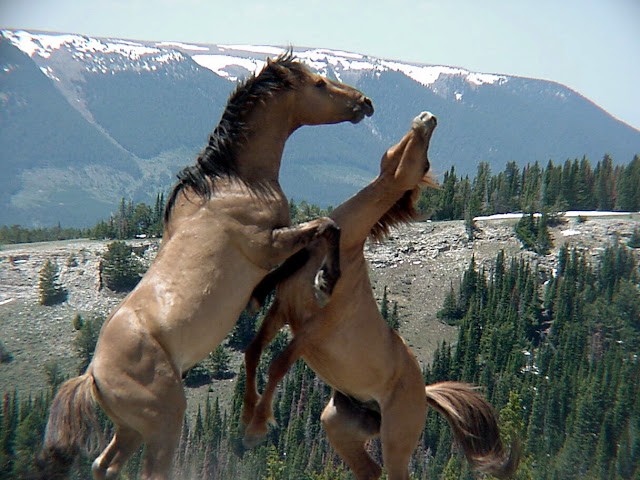This morning the redoubtable Carol Rosin mailed me an article which in the current climate of devastation across our planet and the frightening realisation Earth appears to have crossed its own tipping point and is creaking under the strain along with the fact two-thirds of animals and insects will be extinct by 2020 will leave you staggered.
The post which Carol sent me is from NexusNewsfeed.com who have discovered that the National Wild Horse and Burro Advisory Board, in Colorado, have recklessly voted to approve the shooting of almost 100,000 healthy wild horses and burros.
At a time when we should be finding ways to reverse the death and destruction of our species, it seems man's greed and ignorance is only speeding up the onslaught.
Just last week Keepers warn of 'bee-mageddon' after France authorises controversial insecticide.
The disturbing article came from The Telegraph which claimed: French bee keepers are up in arms over the authorisation of an insecticide they warn could sound the death knell of their already decimated bee population.
Bee hives have been hit in Europe, North America and elsewhere by a mysterious phenomenon called "colony collapse disorder". The blight has been blamed on mites, a virus or fungus, pesticides, or a combination of factors.
With the honey harvest in France down to just 10,000 tons this year - three times less than in the 1990s - the country's national apiculture union, UNAF, slammed what it called the "scandalous" authorisation of sulfaoxaflor, which attacks the central nervous system of insects.
A quotation attributed to Albert Einstein claims: “If the bee disappeared off the surface of the globe then man would only have four years of life left.”
We have known about dying bees and butterflies for years now but you would be shocked to know these two species are just the very tip of the iceberg!
“Moths, hoverflies, wasps, beetles and many other groups are now sparse where once they were abundant.”
According to Buglife wiping squished bugs off your windscreen used to be an annoying summertime task for every motorist.
But experts say the decline of insects in the UK has reached such a critical level that drivers have noticed their front window is now fly, gnat, wasp and moth-free.
It's not just the UK, here in Holland, every summer the Dutch head off south to France, Spain and Portugal for their annual break, reaching the destination with the front of the car covered in insect road-kill with the difficult task of cleaning the front of the vehicle but not anymore, my neighbour couldn't wait to tell me a month ago how his camper was bug free arriving in France after a thousand kilometre journey from Holland.
So where have all the bugs gone?
“This is part of the wholesale loss of small animals in recent decades.
“The public knows about bees and butterflies, but these are just the tips of the iceberg.
“Moths, hoverflies, wasps, beetles and many other groups are now sparse where once they were abundant.”
We can all remember as a child on hot days the car windscreen being covered in dead insects after a journey.
Not these days.
Nature lovers say the increasing use of pesticides and intensive agriculture over the past 50 years could be to blame.
With animals dying by the thousands every week from extreme weather, drought, floods, heatwave etc, and our oceans seemingly dying at an unprecedented rate, surely the powers that be should be looking at ways to preserve our wildlife not kill it.
With our climate changed forever! World population to hit 8 billion and accelerating and the chance our planet could be ruined forever in just a couple of decades is not the time to stop the rape of our world?
In just three years’ time, the World will have lost two-thirds of all wild animals.
This amazing statistic from The Living Planet Index goes on: The number of wild animals living on Earth is set to fall by two-thirds by 2020, according to a new report, part of a mass extinction that is destroying the natural world upon which humanity depends.
The analysis, the most comprehensive to date, indicates that animal populations plummeted by 58% between 1970 and 2012, with losses on track to reach 67% by 2020. Researchers from WWF and the Zoological Society of London compiled the report from scientific data and found that the destruction of wild habitats, hunting and pollution were to blame.
In another report released by journal Science, Advances are claiming the world's primates face an "extinction crisis" with 60% of species now threatened with extinction, according to research.
A global study, involving more than 30 scientists, assessed the conservation status of more than 500 individual species. This also revealed that 75% of species have populations that are declining.
Add to this the unprecedented death of millions of tons of marine life around the world’s oceans and water ways all point to a crisis which has crossed the tipping point.
Just last year NOAA along with NASA claimed 2016 marked three consecutive years of record warmth for the globe with the first eight months of 2016 unprecedented warmth!
With 10 of the 11 warmest years ever recorded coming in the last 16 years, it is fair to claim climate change is climate changed it will never recover.
The Sun had not risen over its horizon for more than two months yet the North Pole was warmer than South of France, Italy, Greece Turkey and Syria this winter and not for the first time either the last couple of years!
The world is creaking under the stress; crops are failing all over the world due to extreme weather, and with 7.5 billion people we can’t possibly feed everyone, even though the West probably throw’s away enough food to feed the poorest.
Brutal outlook for healthy wild horses and burros: BLM calls for shooting 90,000
http://www.thebigwobble.org/2017/10/by-2020-two-thirds-of-all-wild-animals.html


